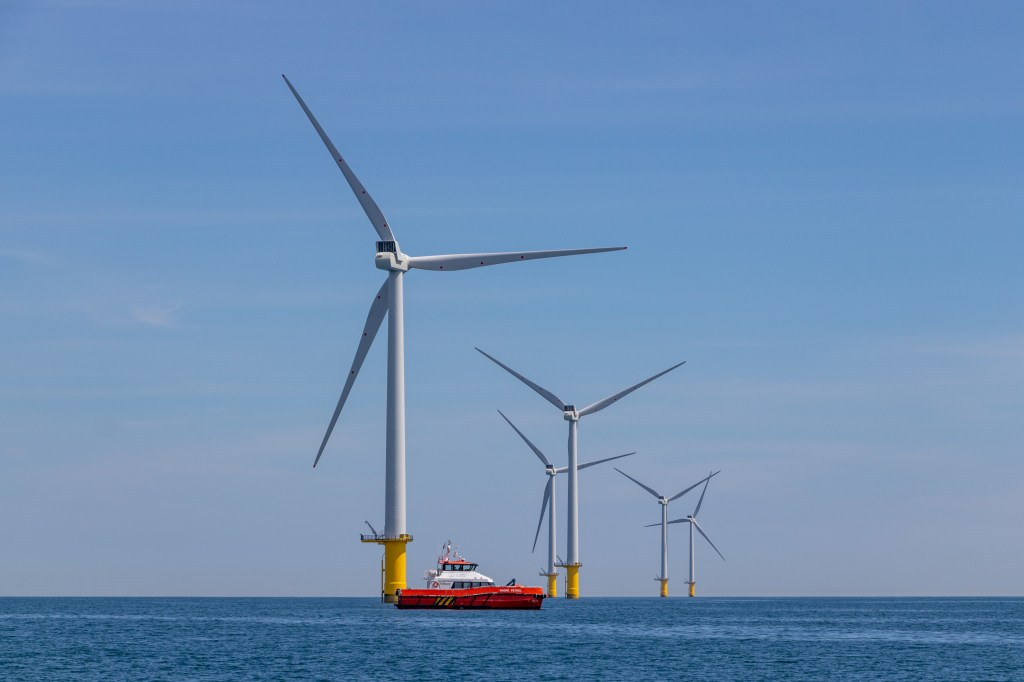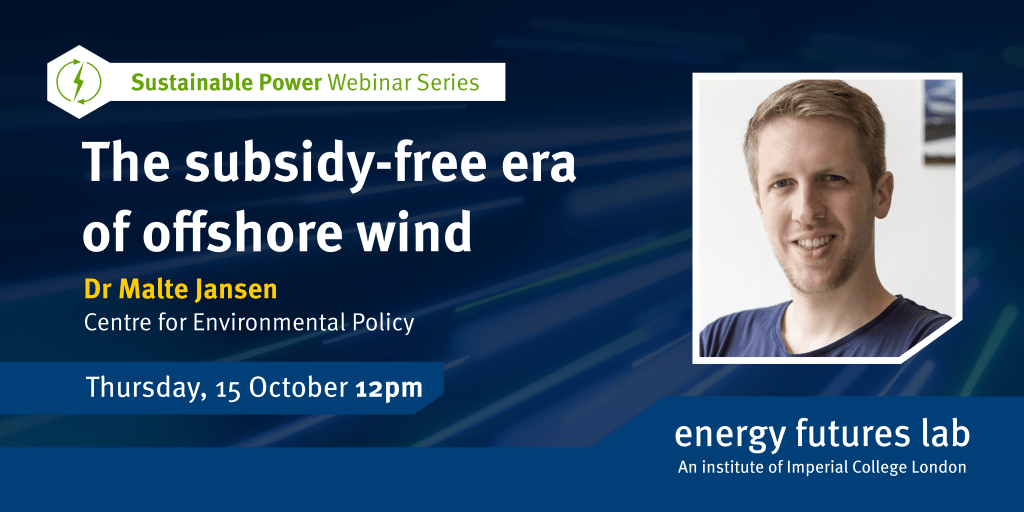Dr Malte Jansen, a Research Associate based in Centre for Environmental Policy at Imperial College London, recently led an international study into the rapidly falling price of offshore wind. The work, published in Nature Energy, has been featured in over 100 news outlets around the world. Malte works on Project 6 of the Integrated Development of Low-carbon Energy Systems (IDLES) programme, working towards energy market design that aligns investor, customer and societal objectives. Here, he reveals how a football match brought together an international team of researchers to show how offshore wind can be built without subsidies.

Offshore wind is cheap… very cheap
Countries around the world have invested heavily in renewable energy sources to decarbonise their electricity systems. Offshore wind is touted as one of the key technologies of the energy system transition with clear advantages when it comes to energy produced per MW of wind turbines installed. In fact, in its 2019 Offshore Wind Outlook special report, the International Energy Agency called it the “only variable baseload power generation technology”. This reduces the challenge of balancing the energy system and allows the generation of energy from an abundant resource to potentially decarbonise the entire energy economy.
Offshore wind had, until recently, however, been viewed by many as a costly option when compared to onshore wind and solar PV, which had already seen large cost reductions. Offshore wind was yet to realise its full cost reduction potential, despite a recent downward trend in auctions. This all changed in April 2017 when German wind farms won bids to build and operate without financial support throughout their lifetime. It made us wonder whether this was here to stay or “Just a flash in the pan?”, our first working title for the paper. With every further auction, it became apparent that this was not the case and we were indeed observing a trend.
The most recently auctioned offshore wind projects will most likely operate with ‘negative subsidies’ – paying money back to consumers and reducing energy bills as the offshore wind farms start producing power in the mid-2020s. This is the conclusion of ‘Offshore wind competitiveness in mature markets without subsidy‘, our article published in Nature Energy. Soon, offshore wind will be so cheap that it will undercut fossil-fuelled power stations and may become the cheapest form of energy for the UK. This is not, however, an article about our research findings, but the story about the joy (and pain) of research, international collaboration and the people behind the science. This is the story behind the paper.
Football
It all started with the European Energy Markets conference 2018 in Lodz, a former industrial city in central Poland. Conferences are one of the best ways to hear about the latest advances in research and find out who is talking about what. The questions asked are just as interesting as the research itself. Here, I met Iegor and Felix who were asking the tough questions of ‘Is Offshore Already Competitive? Analyzing German Offshore Wind Auctions‘ following the spectacularly low auction results in Germany. It was probably the best paper of the conference.
That day, Germany was set to play in a quadrennial football competition, and we all decided to go watch the game together with cold beer on a summer’s day. It wasn’t looking good for Germany as they had already lost the previous game. After 45 minutes, it was pretty much clear how the game would end. Plenty of time in the second half, then, to start engaging in conversations around offshore wind, auctions and the beauty of energy markets with Iegor and Felix. We decided there and then it would be great opportunity to work together. Germany losing the match was a blessing in disguise.
Networking cannot be overrated. Meeting people at a conference and throughout working life brings together the excellence that is needed for writing a paper. And then it takes people to ask really tough questions to figure out the journey. In the fight against climate change, the use of video-conference tool is certainly useful, but without this conference, the paper would not have been.
Collaboration is key
Initial conversations made it clear that we needed to cover the largest offshore wind markets, which happen to be in Europe. With a little bit of research, we quickly figured out that it is close to impossible to understand, correctly describe and replicate each auction design. There is more to it than the blank results and what seem to be the relevant pieces of legislation. To fully understand each country’s position, we needed to know the history, the overarching policy paradigms and all those little rules that no talks about outside their respective mother tongue.
Those initial discussions established the need to assemble an international team to look at each of the largest offshore wind markets in Europe; we needed the experts from each country. This is where the power of networking comes in. Attending conferences over the years and working on European projects really has enabled this kind of research. Without the chance encounters and relationships they facilitate, we wouldn’t have been able to come together. Once we had assembled our team, it was a matter of sticking our heads together and making sense of everything. We had started with a more or less clear idea of what we deemed interesting. It took a while for us to truly understand each country’s perspective in all its details.
With this valuable exchange of ideas and facts, we were able to ask the right question. Having the experts in their field gathered together doesn’t mean it is plain sailing, though. Quite the contrary, in fact. With so many years of experience in offshore wind between us, we realised how different our approaches were, right from the technology to the economics of it. What it really enabled us to do was to ask the tough questions. One of the many memorable discussions we had early on was on the discrepancy between levelised cost of electricity and the auction results. The economic theory of the cost reduction was not supported by reality. This not only informed the core of our study but was elegantly summed up by a co-author with years of experience in the area: “How did we not see this coming?!”
“It takes two weeks,” he said!
Research takes time. A lot of time. The is no such thing as a ‘quick research paper’. What started out as a simple idea to describe offshore auction across Europe turned into an elaborate process. Considering it took us two years from the initial ideas over football and beer (very cliché, I know), it is probably fair to say that some of the co-authors would never have signed up had they known what was going to happen.
The luxury of time allowed us to develop a working hypothesis which was then confirmed bit by bit, as new bid results rolled in, each one cheaper than the last. I guess this is the beauty of working on something that is so close to reality. Our curiosity-driven approach meant that we were doing science ‘on the fly’, piecing the puzzle together as we kept discovering new facts. It’s a little bit like a stroll in a new city, walking around the streets and slowly forming a picture in your head, but for research.
Science at its finest!
The beauty of collaboration is the exploratory nature of discovering each other’s perspective. This creates a space where no stone is left unturned, no question is considered too trivial and no direction of research considered unnecessary. Each question raised needs to be answered but doing so throws up three new ones. By the end of the process, we had built a mutual understanding on what the real problems were and how we could address them with our research to cover all countries. This is the strength when entering into an unknown territory with a diverse team and ultimately helps to write a paper that matters and which is likely to be valid outside its geographic study area. The fact that we didn’t quite know what we are getting ourselves into and that we were doing research ‘on the fly’ as questions kept popping up (i.e. being asked by very inquisitive co-authors) made it the most fun and rewarding experience. This was science at its purest!
Note:
This article was first published on the community websites of Behavioural and Social Sciences at Nature Research (https://socialsciences.nature.com/posts/the-era-of-subsidy-free-offshore-wind) on the 27th of July. The corresponding “Offshore wind competitiveness in mature markets without subsidy” published in Nature Energy on the same day.
Webinar:
On 15 October, Malte will deliver an Energy Futures Lab lunchtime webinar on his research. Register here.

Biography
Dr Malte Jansen is a Research Associate specialising in energy systems with high shares of renewables, at the Centre of Environmental Policy at Imperial College London. He is an expert in renewable and conventional power plant technology, energy market design, econometric modelling and sustainable energy engineering and wind power forecasting. He is a co-convenor for the Energy Policy option of the MSc Environmental Technology. He is one of the founders of Power Swarm, a network for academics, industry and government experts working on power system transformation. Malte’s research has shown large impact in the public domain, leading the debate on the energy system’s policy. His commentary has appeared in Financial Times, Der Spiegel, New Scientist, neue energie, EW Magazin, detektor.FM, ZfK and energate messenger. Malte has worked five years as part of the research team at Fraunhofer IWES (now IEE) in Germany, focussing on energy market design and the markets for ancillary services. His input to energy market reform in Germany directly shaped the rules for future market design, allowing renewables to contribute towards power system security. Recent appointments as a Consultant at E4tech have been on projects in energy systems, sector coupling, demand response and water electrolysis. Malte is a doctor of energy economics (Dr. rer. pol.) and wrote his thesis on the economics of wind and solar in markets for power system reserve. He holds degrees in engineering and economics.
